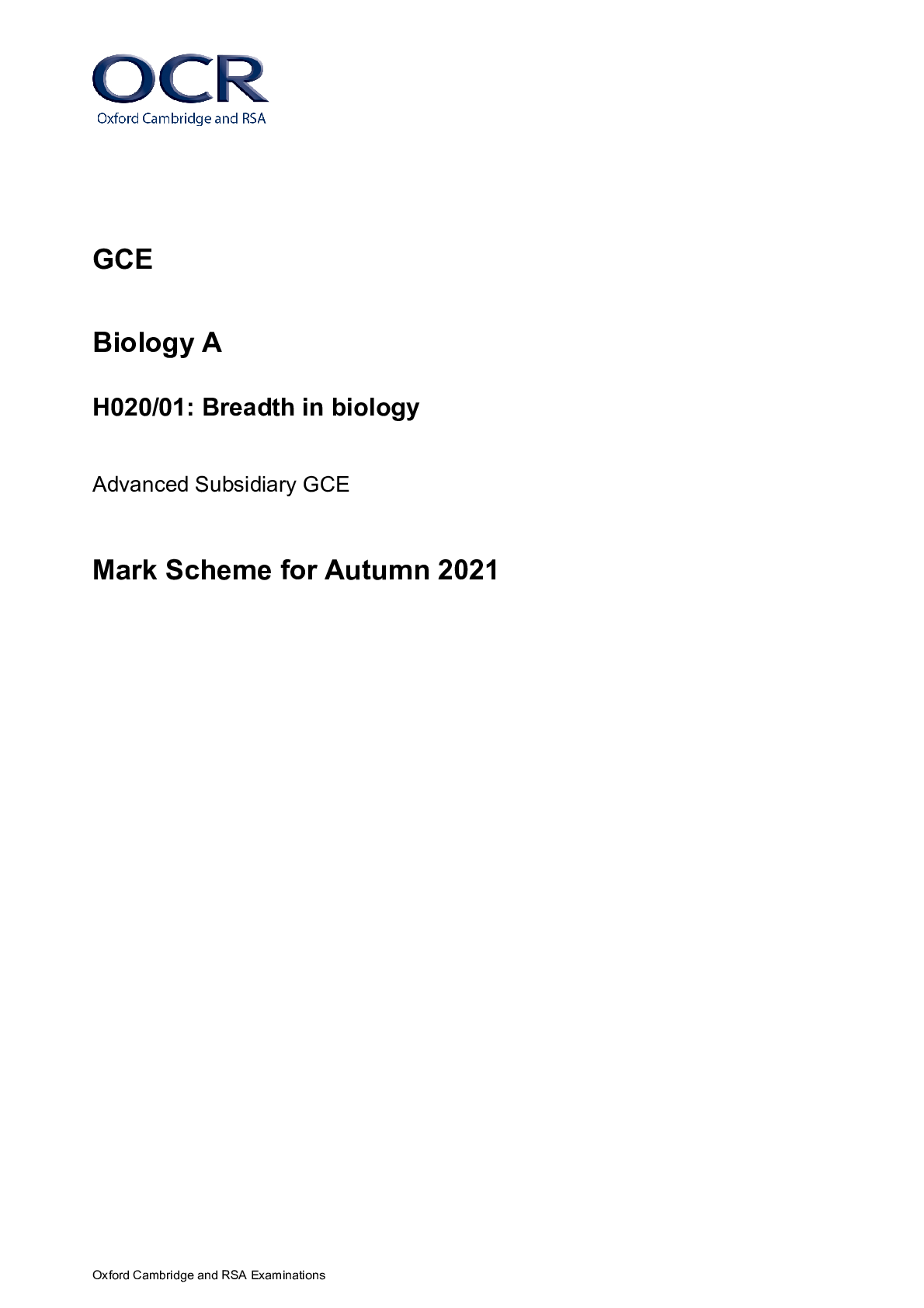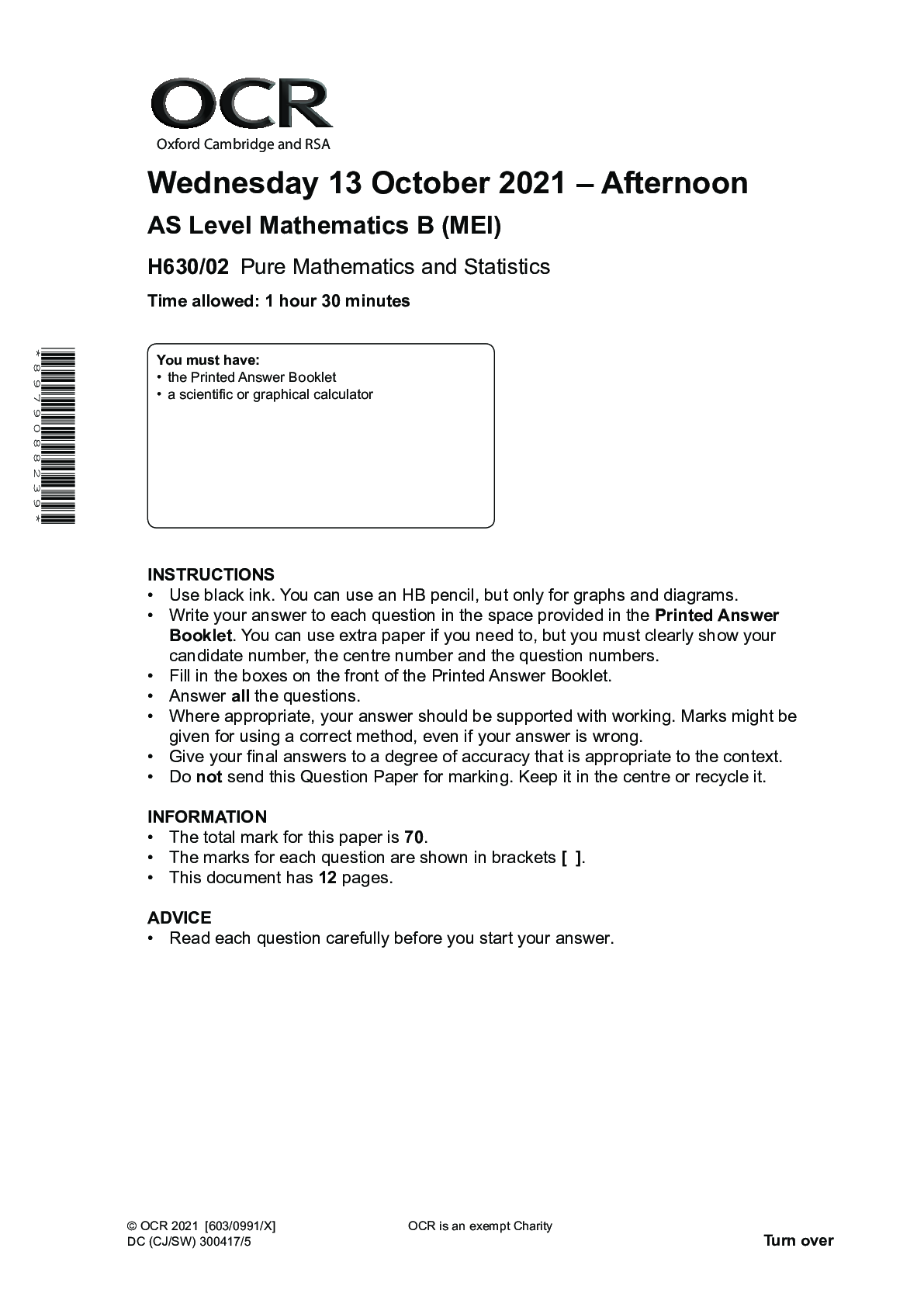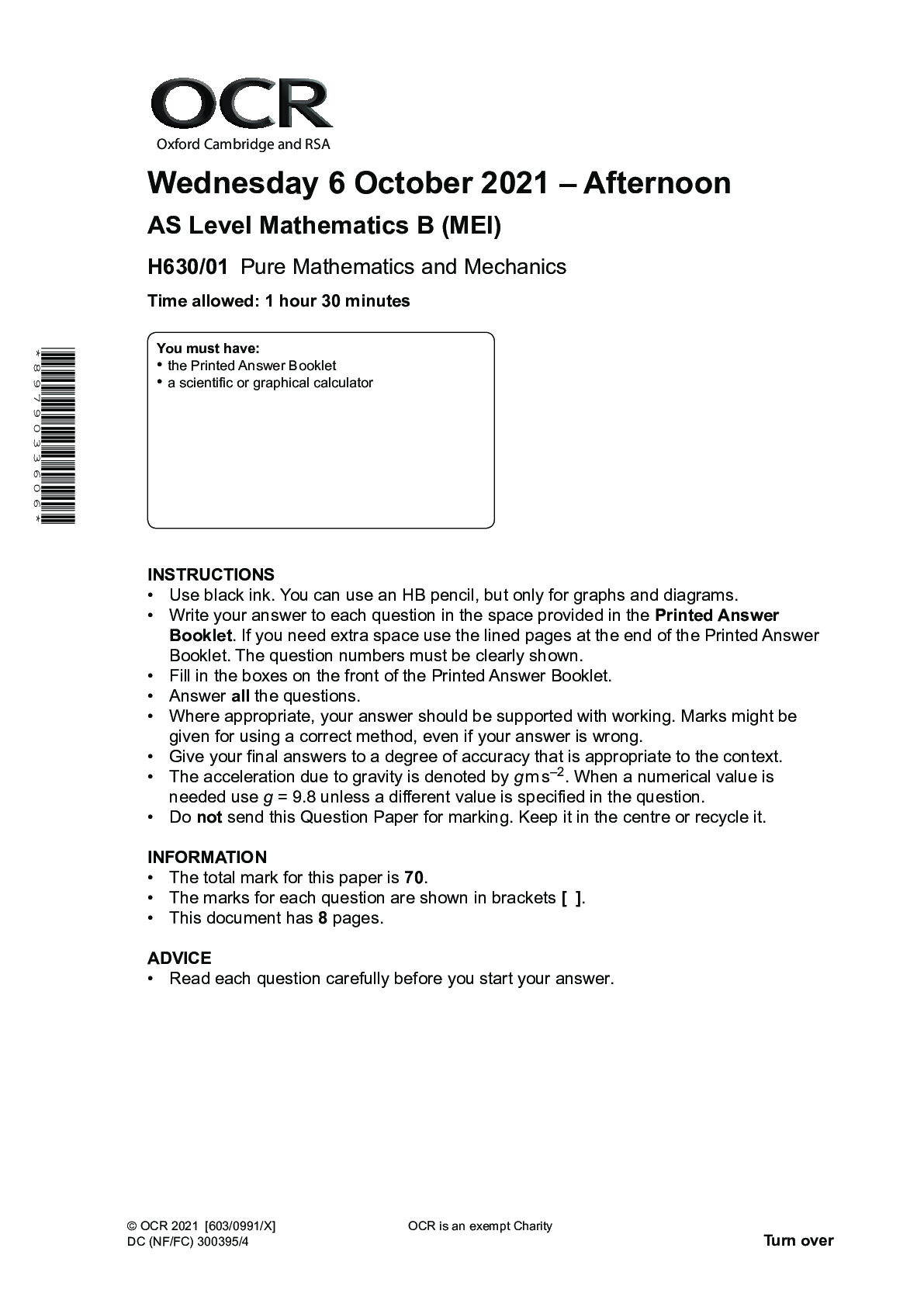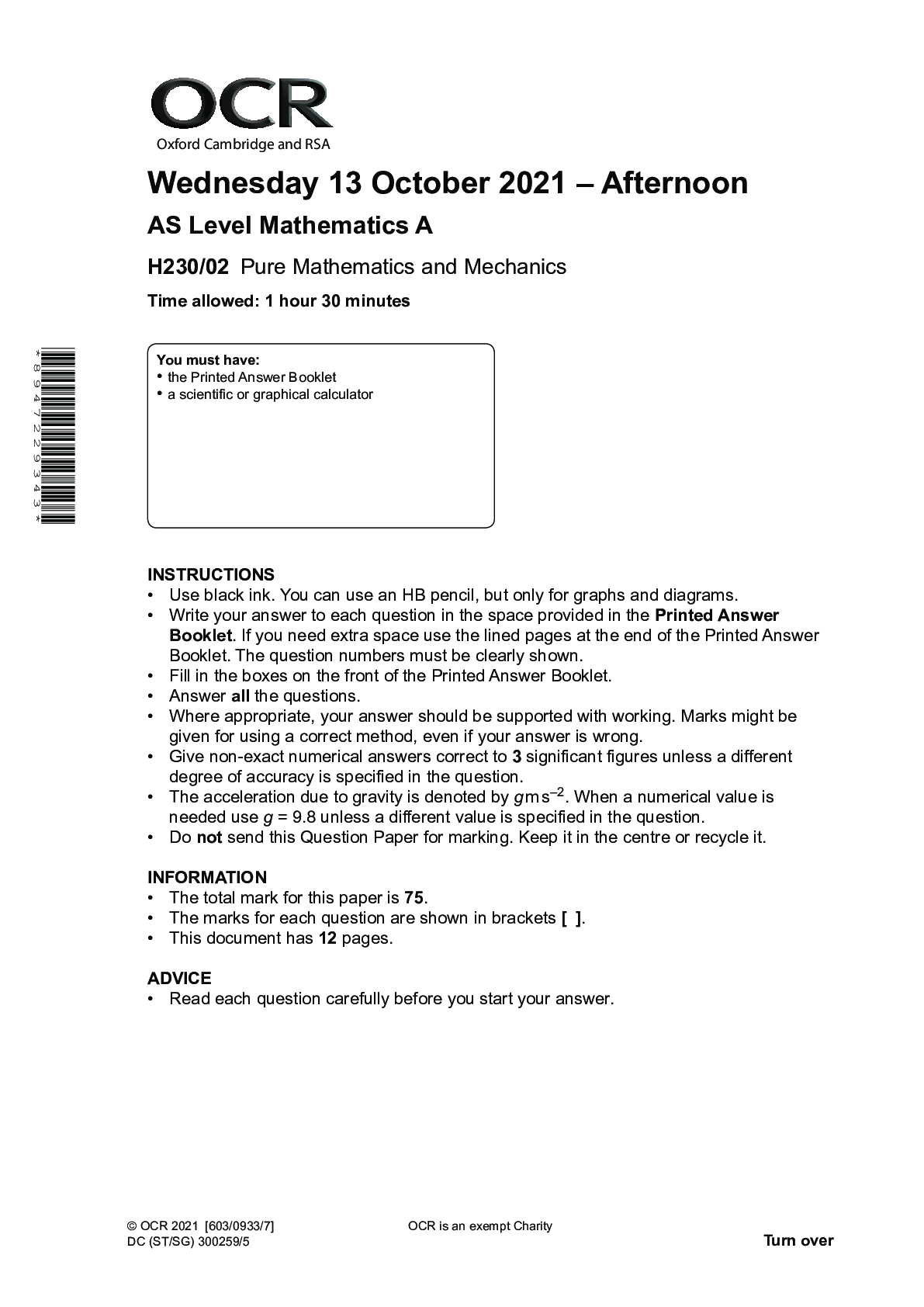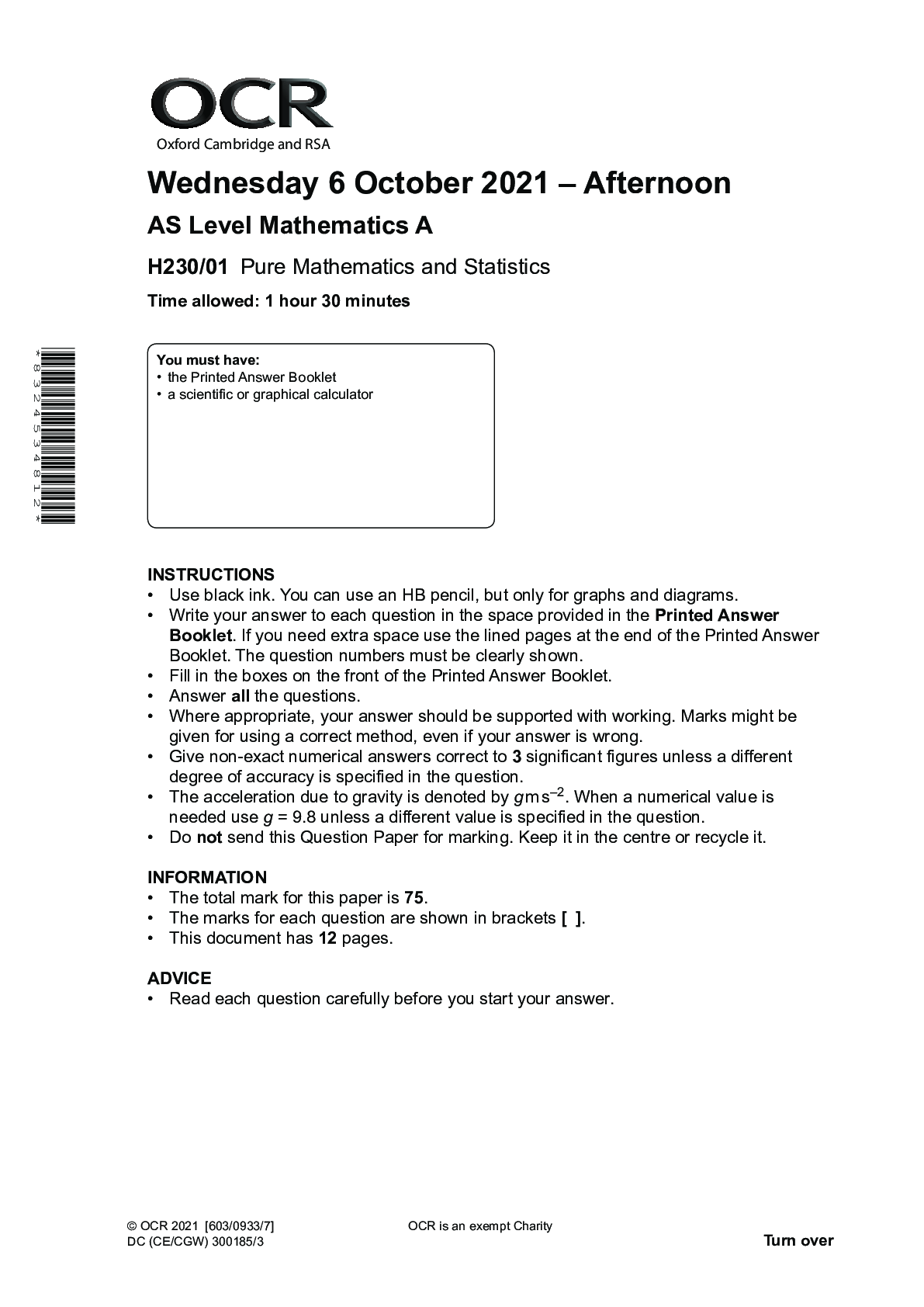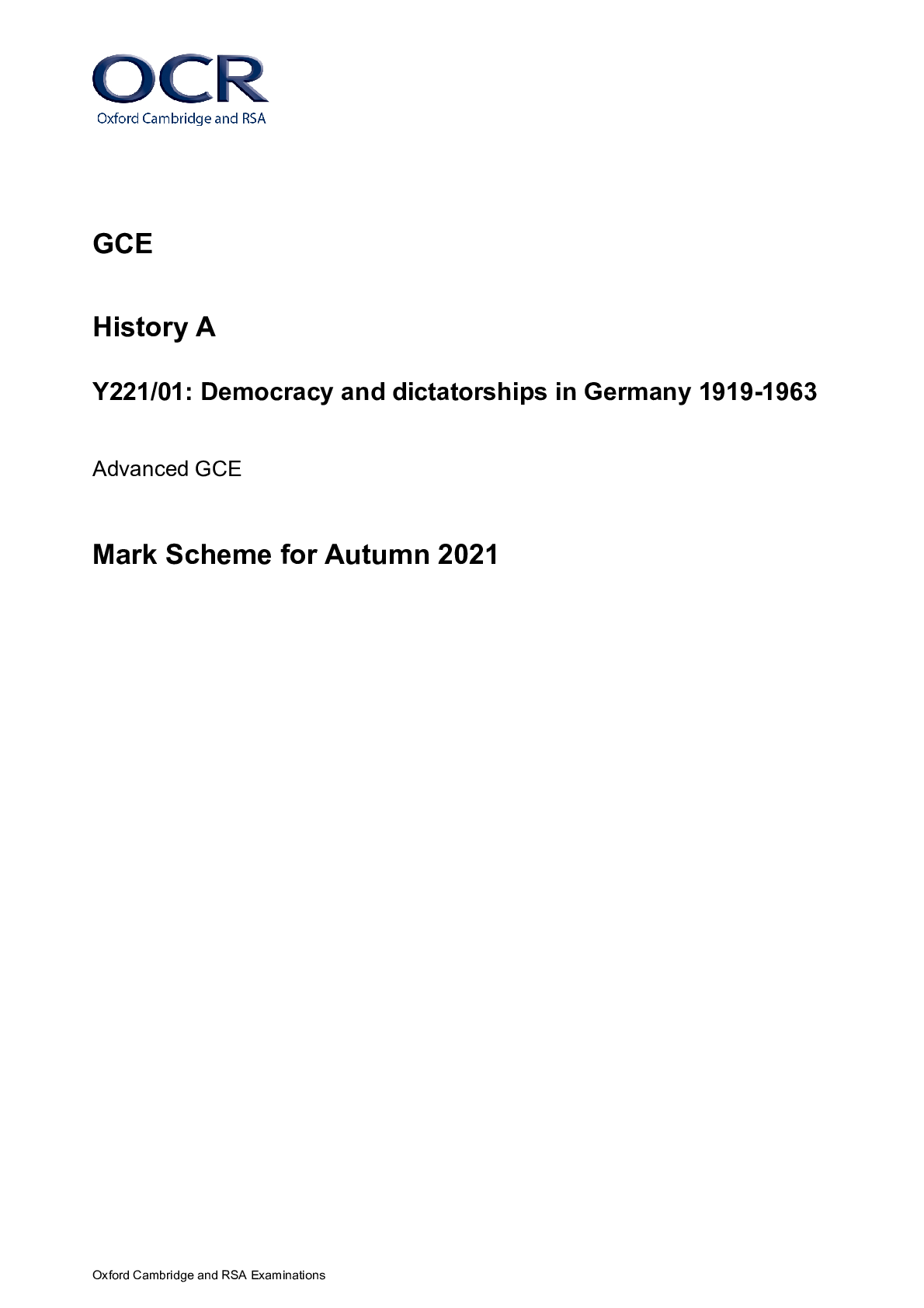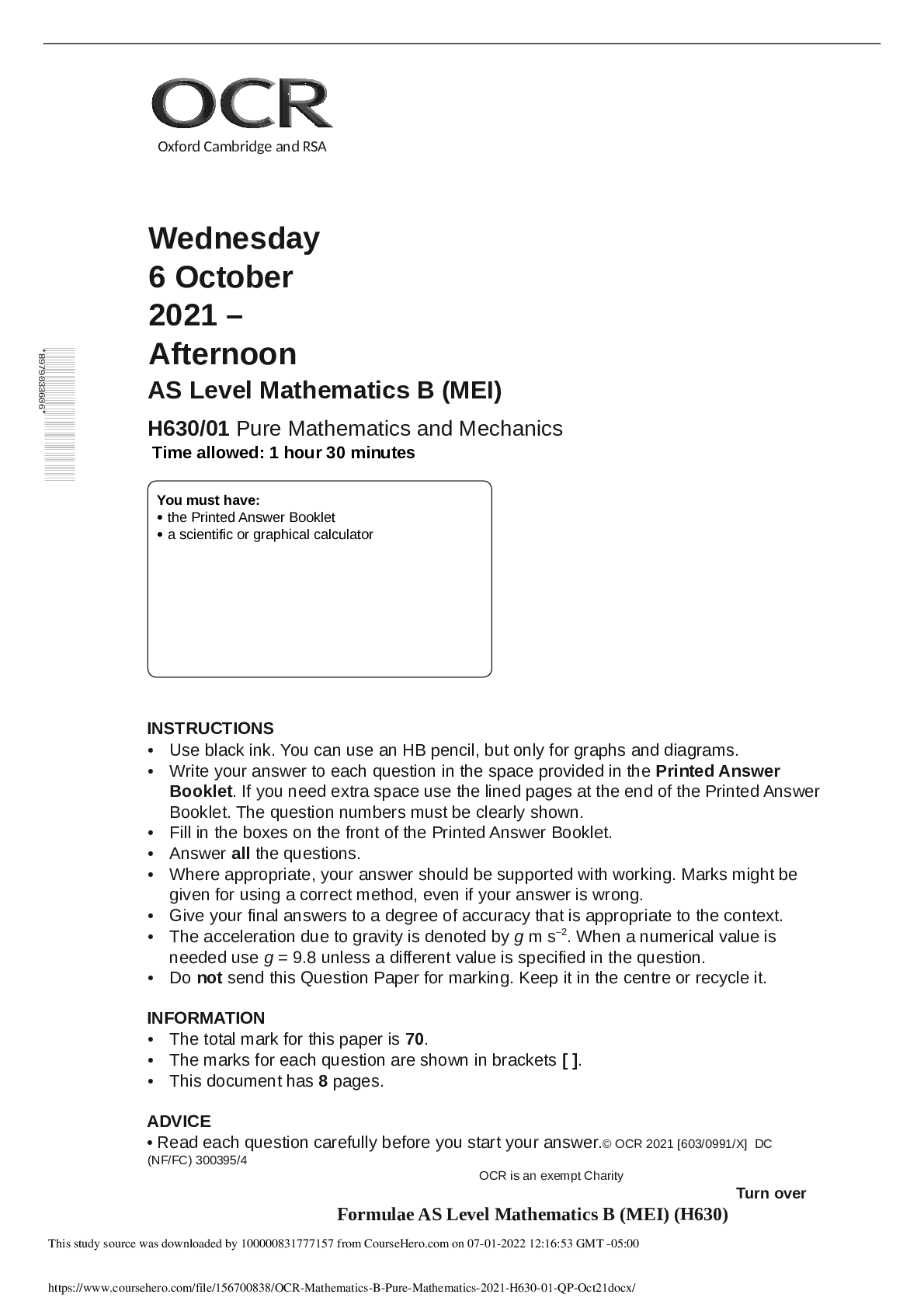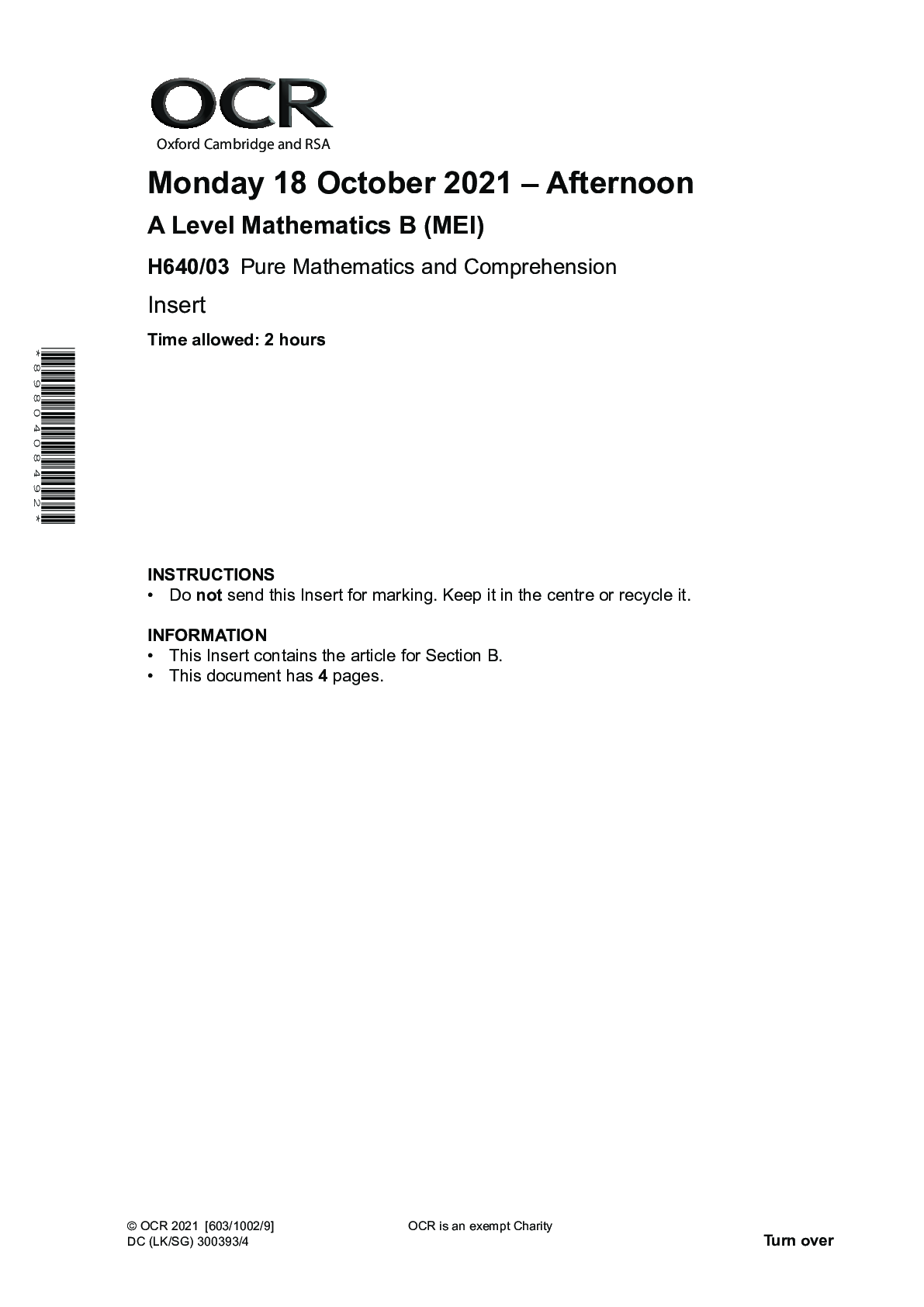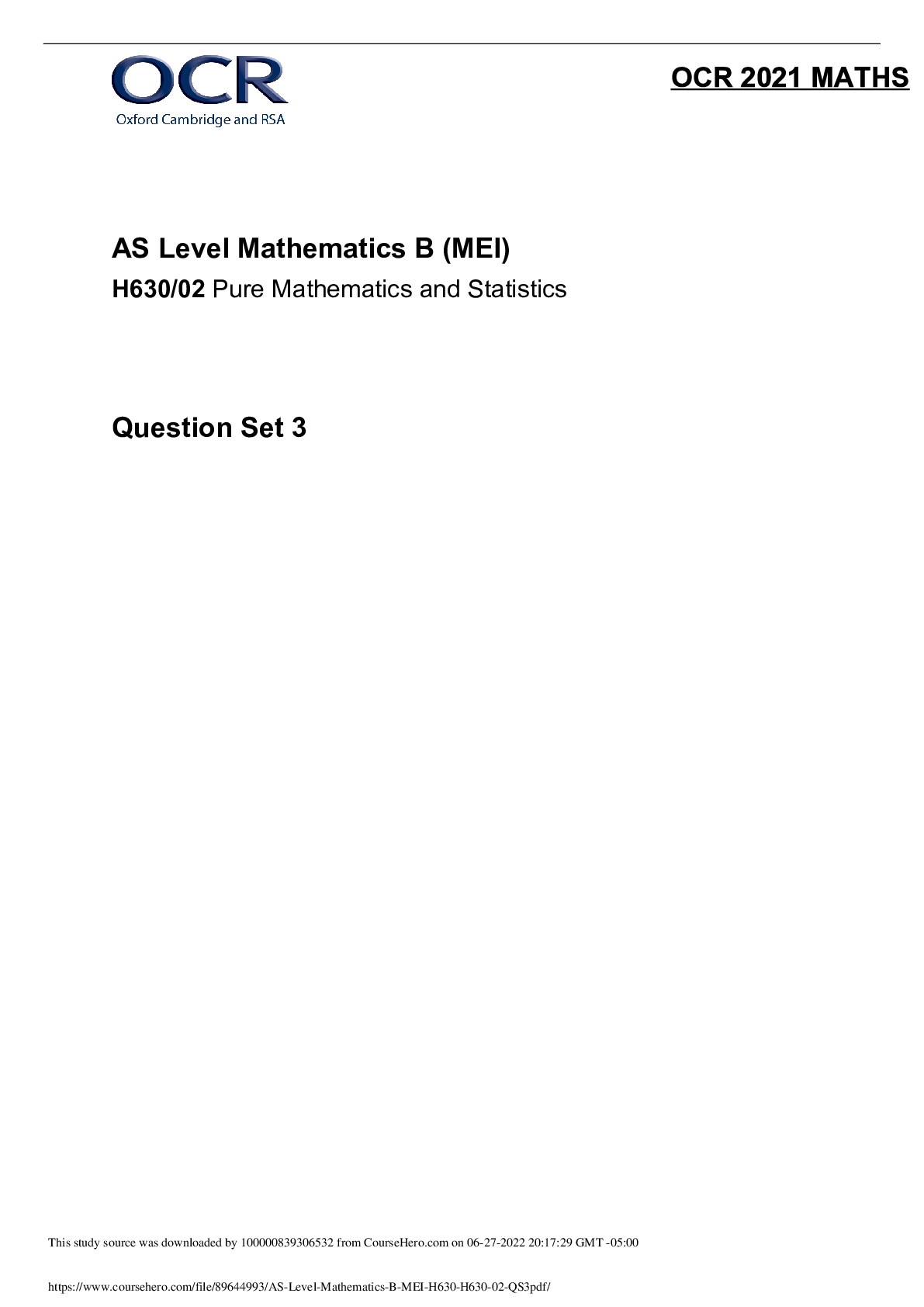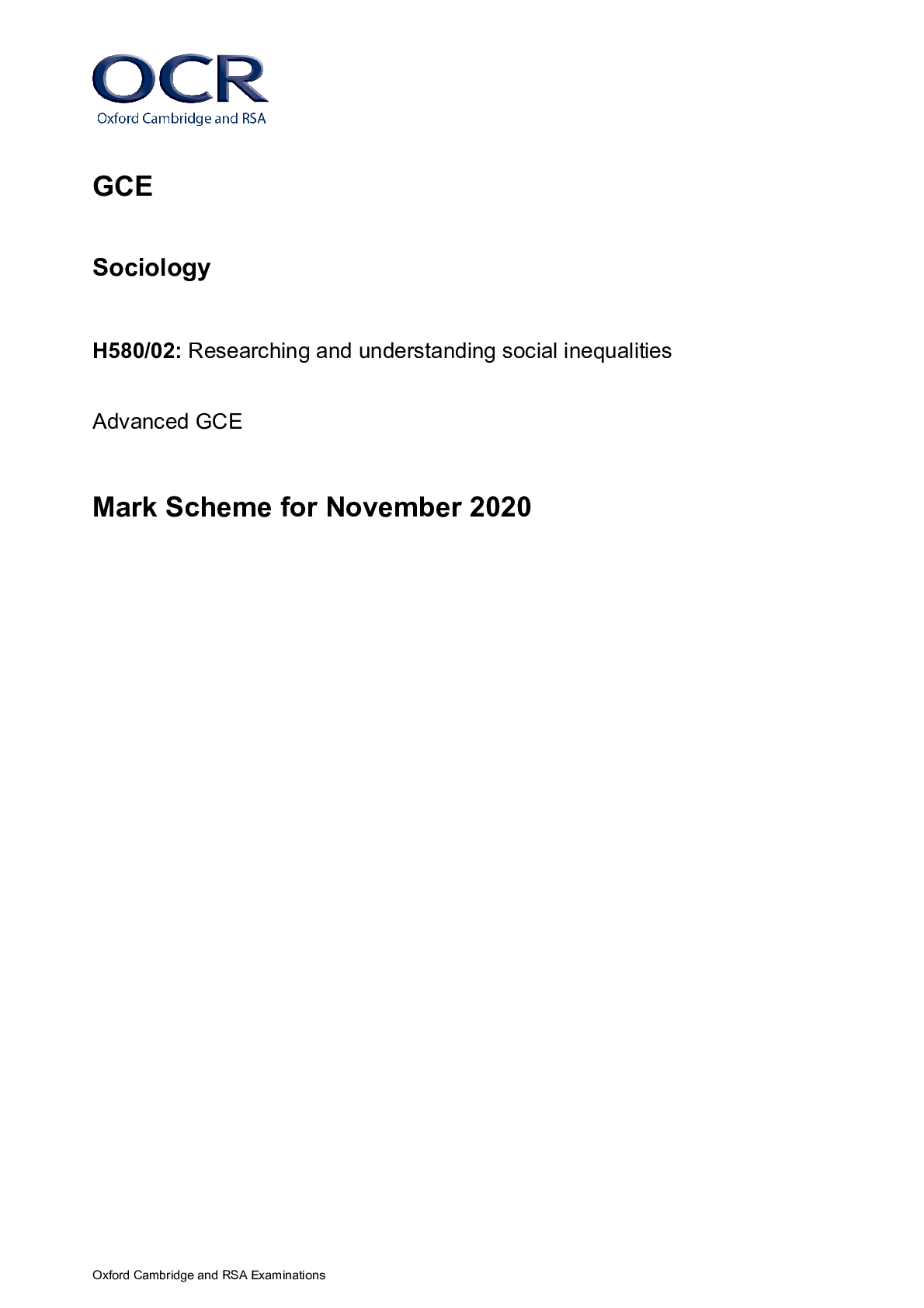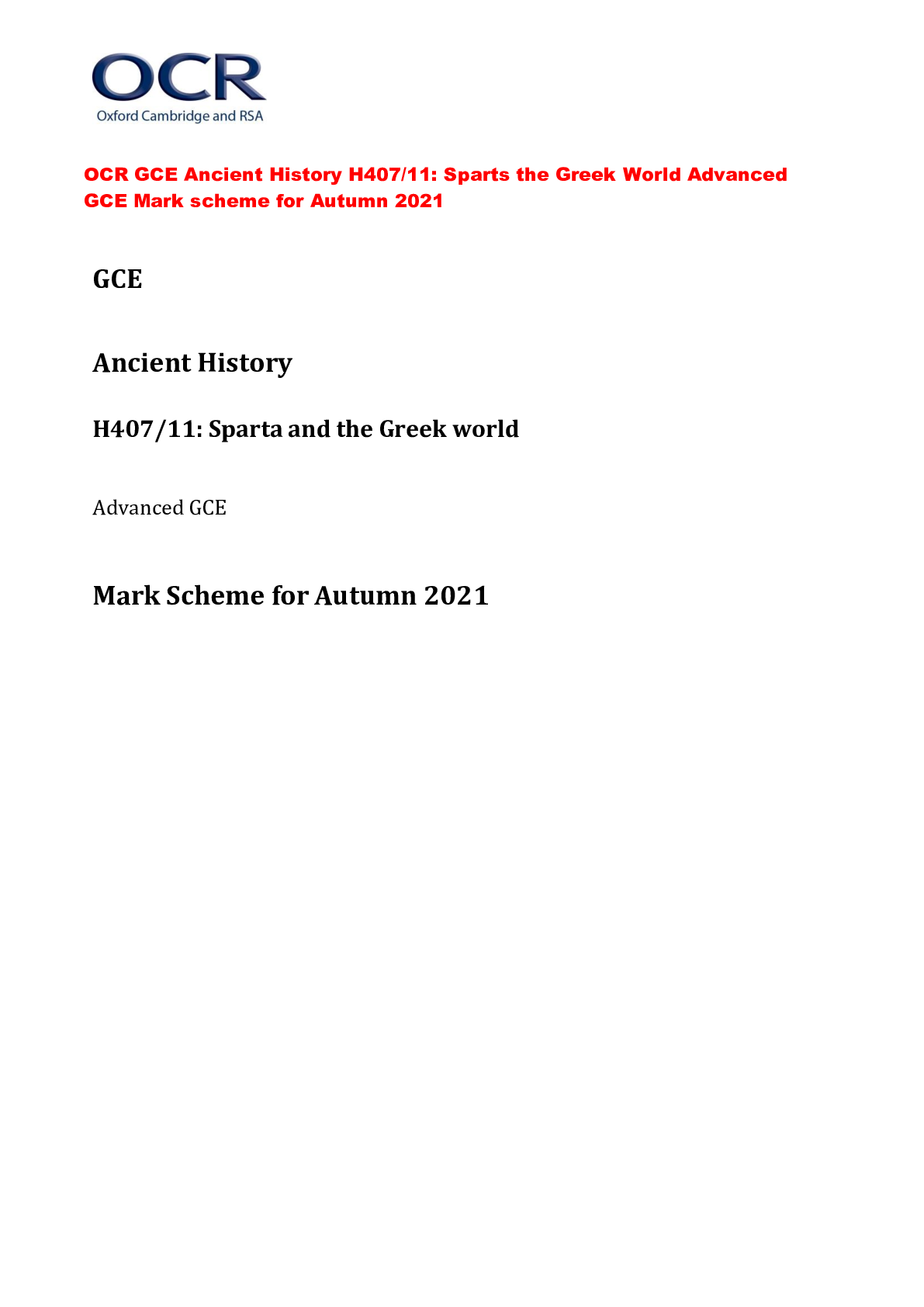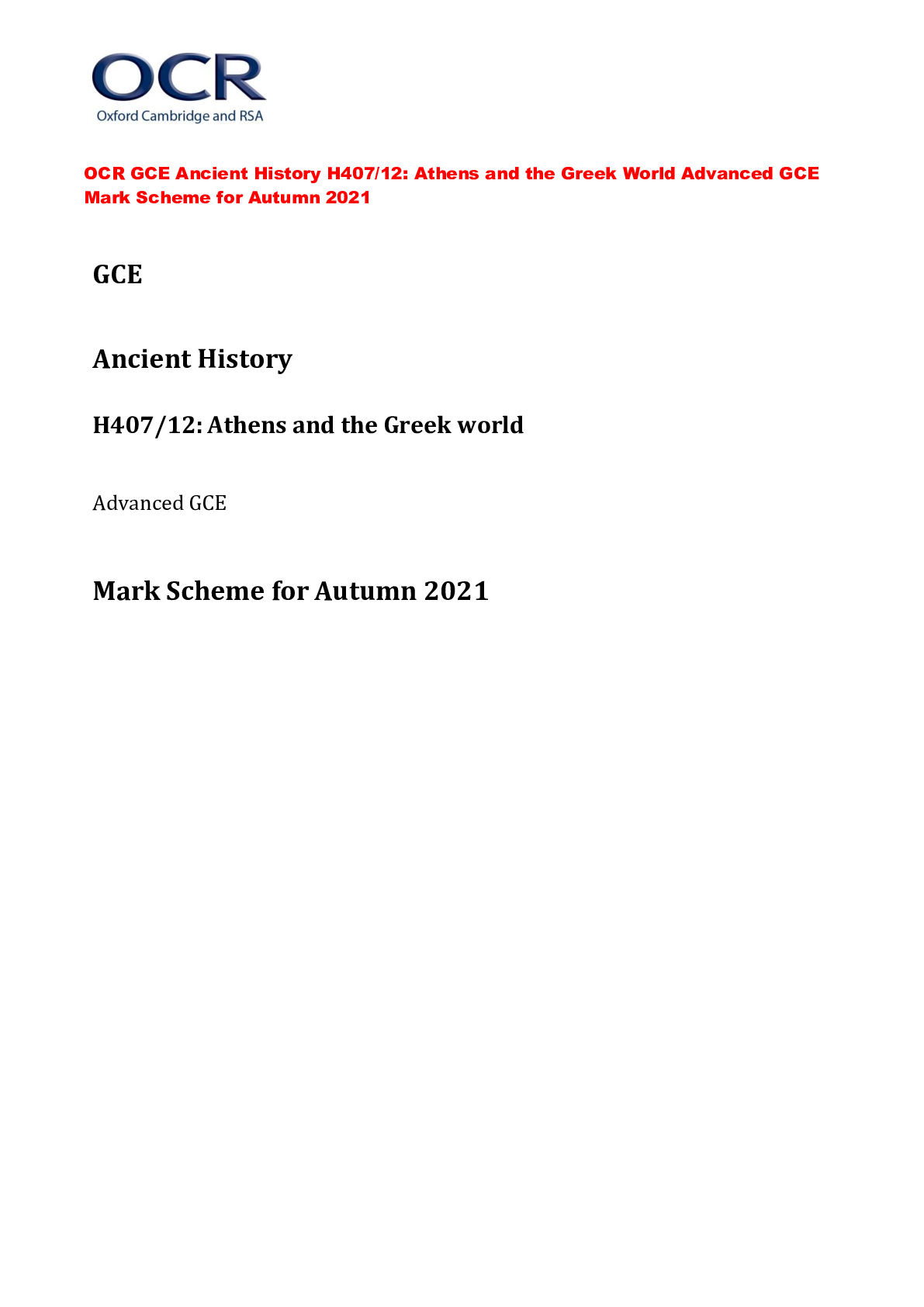Mathematics > Higher Education > GCE Mathematics B (MEI) H630/01: Pure Mathematics and Mechanics Advanced Subsidiary GCE Mark Scheme (All)
GCE Mathematics B (MEI) H630/01: Pure Mathematics and Mechanics Advanced Subsidiary GCE Mark Scheme for Autumn 2021. 100% proven pass rate.
Document Content and Description Below
Annotations and abbreviations Annotation in scoris Meaning and BOD Benefit of doubt FT Follow through ISW Ignore subsequent working M0, M1 Method mark awarded 0, 1 A0, A1 Accuracy mark a... warded 0, 1 B0, B1 Independent mark awarded 0, 1 SC Special case ^ Omission sign MR Misread Highlighting Other abbreviations in mark scheme Meaning E1 Mark for explaining a result or establishing a given result dep* Mark dependent on a previous mark, indicated by * cao Correct answer only oe Or equivalent rot Rounded or truncated soi Seen or implied www Without wrong working AG Answer given awrt Anything which rounds to BC By Calculator DR This indicates that the instruction In this question you must show detailed reasoning appears in the question.H630/01 Mark Scheme November 2021 2. Subject-specific Marking Instructions for AS/A Level Mathematics B (MEI) a Annotations should be used whenever appropriate during your marking. The A, M and B annotations must be used on your standardisation scripts for responses that are not awarded either 0 or full marks. It is vital that you annotate standardisation scripts fully to show how the marks have been awarded. For subsequent marking you must make it clear how you have arrived at the mark you have awarded. b An element of professional judgement is required in the marking of any written paper. Remember that the mark scheme is designed to assist in marking incorrect solutions. Correct solutions leading to correct answers are awarded full marks but work must not be judged on the answer alone, and answers that are given in the question, especially, must be validly obtained; key steps in the working must always be looked at and anything unfamiliar must be investigated thoroughly. Correct but unfamiliar or unexpected methods are often signalled by a correct result following an apparently incorrect method. Such work must be carefully assessed. When a candidate adopts a method which does not correspond to the mark scheme, escalate the question to your Team Leader who will decide on a course of action with the Principal Examiner. If you are in any doubt whatsoever you should contact your Team Leader. c The following types of marks are available. M A suitable method has been selected and applied in a manner which shows that the method is essentially understood. Method marks are not usually lost for numerical errors, algebraic slips or errors in units. However, it is not usually sufficient for a candidate just to indicate an intention of using some method or just to quote a formula; the formula or idea must be applied to the specific problem in hand, e.g. by substituting the relevant quantities into the formula. In some cases the nature of the errors allowed for the award of an M mark may be specified. A Accuracy mark, awarded for a correct answer or intermediate step correctly obtained. Accuracy marks cannot be given unless the associated Method mark is earned (or implied). Therefore M0 A1 cannot ever be awarded. B Mark for a correct result or statement independent of Method marks. E A given result is to be established or a result has to be explained. This usually requires more working or explanation than the establishment of an unknown result. Unless otherwise indicated, marks once gained cannot subsequently be lost, e.g. wrong working following a correct form of answer is ignored. Sometimes this is reinforced in the mark scheme by the abbreviation isw. However, this would not apply to a case where a candidate passes through the correct answer as part of a wrong argument.H630/01 Mark Scheme November 2021 d When a part of a question has two or more ‘method’ steps, the M marks are in principle independent unless the scheme specifically says otherwise; and similarly where there are several B marks allocated. (The notation ‘dep*’ is used to indicate that a particular mark is dependent on an earlier, asterisked, mark in the scheme.) Of course, in practice it may happen that when a candidate has once gone wrong in a part of a question, the work from there on is worthless so that no more marks can sensibly be given. On the other hand, when two or more steps are successfully run together by the candidate, the earlier marks are implied and full credit must be given. e The abbreviation FT implies that the A or B mark indicated is allowed for work correctly following on from previously incorrect results. Otherwise, A and B marks are given for correct work only – differences in notation are of course permitted. A (accuracy) marks are not given for answers obtained from incorrect working. When A or B marks are awarded for work at an intermediate stage of a solution, there may be various alternatives that are equally acceptable. In such cases, what is acceptable will be detailed in the mark scheme. If this is not the case, please escalate the question to your Team Leader who will decide on a course of action with the Principal Examiner. Sometimes the answer to one part of a question is used in a later part of the same question. In this case, A marks will often be ‘follow through’. In such cases you must ensure that you refer back to the answer of the previous part question even if this is not shown within the image zone. You may find it easier to mark follow through questions candidate-by-candidate rather than question-by-question. f Unless units are specifically requested, there is no penalty for wrong or missing units as long as the answer is numerically correct and expressed either in SI or in the units of the question. (e.g. lengths will be assumed to be in metres unless in a particular question all the lengths are in km, when this would be assumed to be the unspecified unit.) We are usually quite flexible about the accuracy to which the final answer is expressed; over-specification is usually only penalised where the scheme explicitly says so. • When a value is given in the paper only accept an answer correct to at least as many significant figures as the given value. • When a value is not given in the paper accept any answer that agrees with the correct value to 2 s.f. NB for Specification A the rubric specifies 3 s.f. as standard, so this statement reads “3 s.f” Follow through should be used so that only one mark is lost for each distinct accuracy error. g Rules for replaced work: if a candidate attempts a question more than once, and indicates which attempt he/she wishes to be marked, then examiners should do as the candidate requests; if there are two or more attempts at a question which have not been crossed out, examiners should mark what appears to be the last (complete) attempt and ignore the others. NB Follow these maths-specific instructions rather than those in the assessor handbook. h For a genuine misreading (of numbers or symbols) which is such that the object and the difficulty of the question remain unaltered, mark according to the scheme but following through from the candidate’s data. A penalty is then applied; 1 mark is generally appropriate, though this may differ for some units. This is achieved by withholding one A mark in the question. Marks designated as cao may be awarded as long as there are no other errors. E marks are lost unless, by chance, the given results are established by equivalent working. ‘Fresh starts’ will not affect an earlier decision about a misread. Note that a miscopy of the candidate’s own working is not a misread but an accuracy error. i If a calculator is used, some answers may be obtained with little or no working visible. Allow full marks for correct answers (provided, of course, that there is nothing in the wording of the question specifying that analytical methods are required). Where an answer is wrong but there is some evidence of method, allow appropriate method marks. Wrong answers with no supporting method score zero. If in doubt, consult your Team Leader. j If in any case the scheme operates with considerable unfairness consult your Team Leader.H630/01 Mark Scheme November 2021 Question Answer Marks AOs Guidance 1 Solving y = 3x – 2 and x + 2y = 10 simultaneously e.g. x x + − = 2(3 2) 10 or 6 2 4 2 10 x y x y − = + = 7 14 2 x x = ⇒ = When x y = = 2, 4 [So the point of intersection is (2, 4)] M1 A1 [2] 1.1 1.1 Attempt at elimination or substitution or solution of simultaneous equations BC cao May be implied by the correct answers; award full marks for correct BC solution 2 Using suvat equation(s) with s u t = = = 1.5, 0, 0.9 1 2 2 1 2 1.5 0.9 2 s ut at a = + = × Giving a = 3.70 m s–2 M1 A1 [2] [Show More]
Last updated: 1 year ago
Preview 1 out of 14 pages
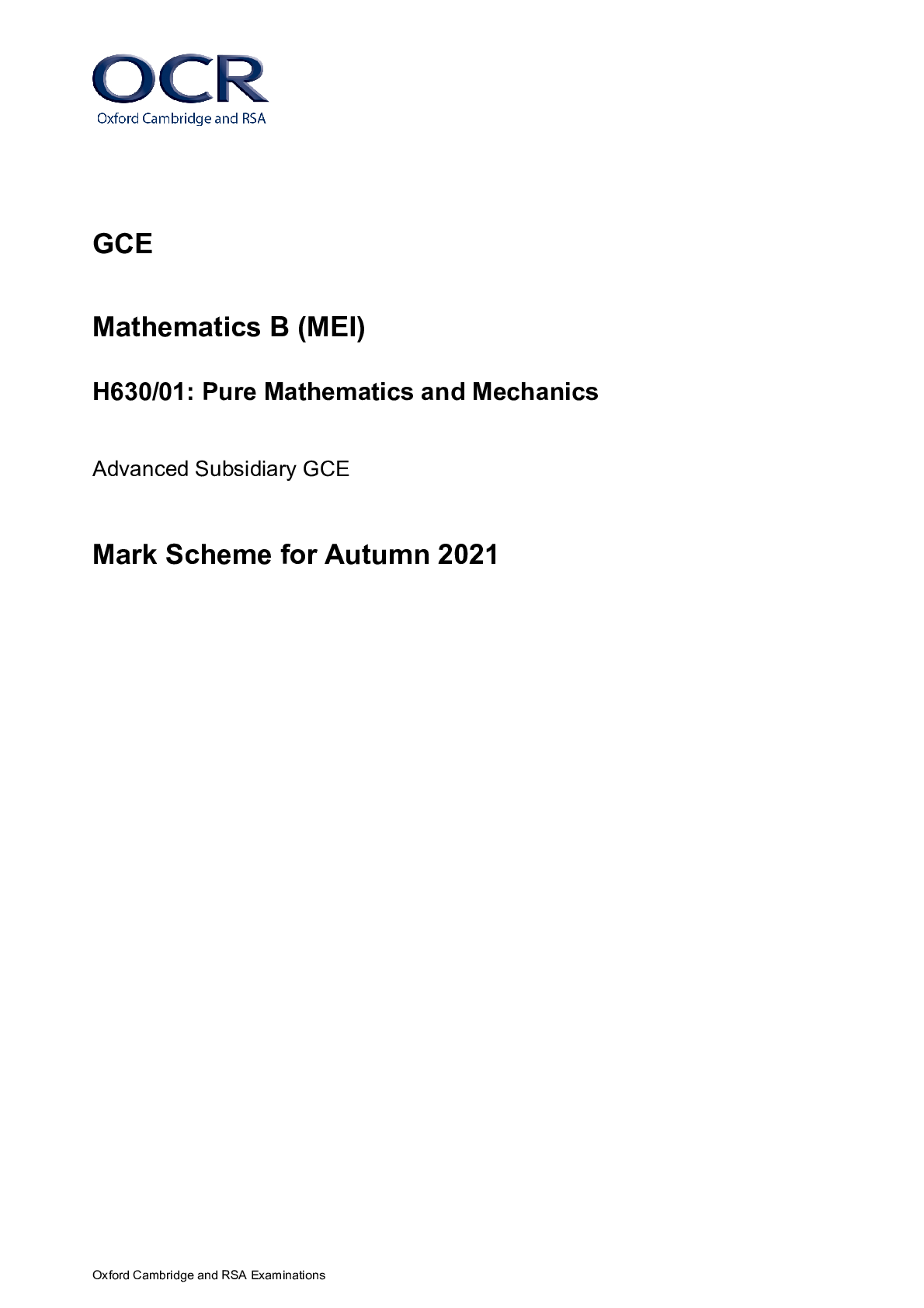
Reviews( 0 )
Document information
Connected school, study & course
About the document
Uploaded On
Jun 28, 2022
Number of pages
14
Written in
Additional information
This document has been written for:
Uploaded
Jun 28, 2022
Downloads
0
Views
70

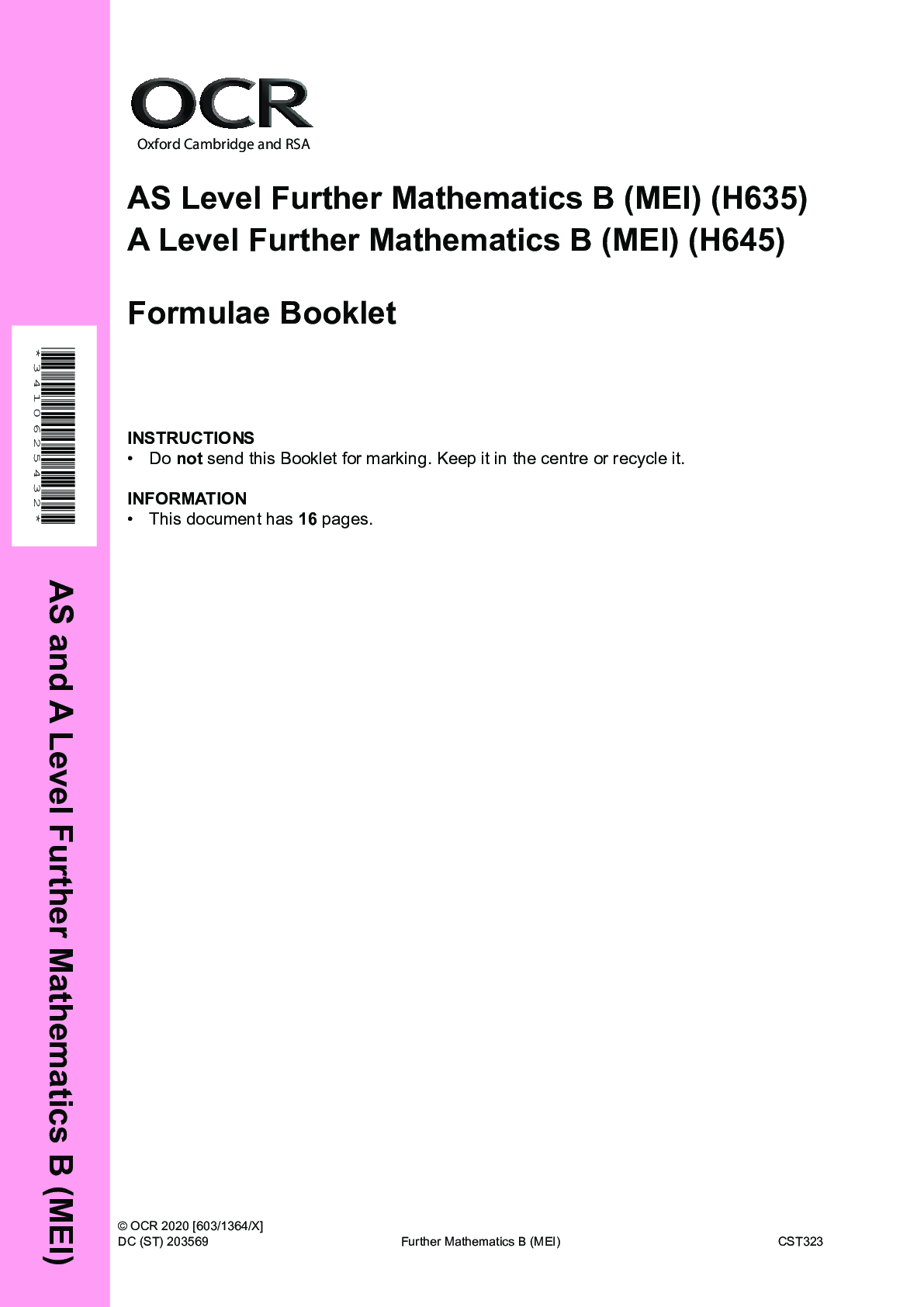
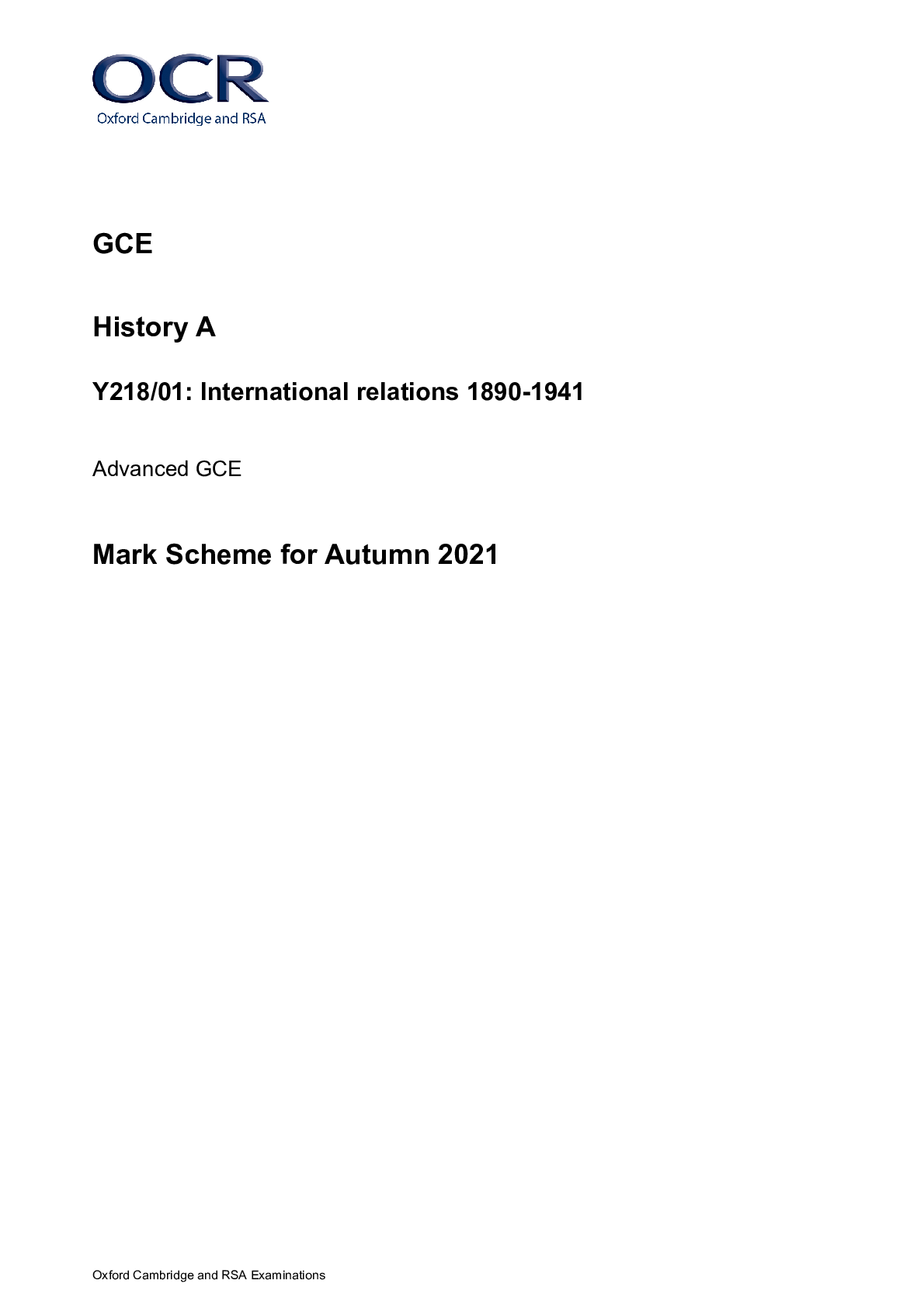



.png)
